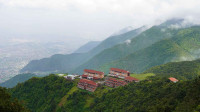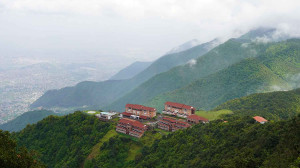Money
Forecasts of less rain this year alarm farm sector
The climate outlook for the 2023 southwest monsoon season shows that most of Nepal may receive below-normal rainfall.
Sangam Prasain
Nepali farmers depend on the heavens to water their crops, and reports of possibly less rain this year has set alarm bells ringing. South Asian meteorologists have said that most of Nepal is likely to experience below-normal monsoon rains or drought-like situations in the days ahead after three years of normal rainfall.
Experts say below-normal monsoon is not good news for a rain-fed economy like Nepal which is going through a recession.
The country’s policymakers, who are already grappling with higher inflation, may be prompted to change their outlook with the farm sector—the only bright spot in its slowing economy this fiscal year—facing potentially dry conditions and heat waves.
Below-normal rainfall and above-normal temperature conditions could lower crop production and hurt efforts to control food costs. In the last four years, Nepal’s economy has slowed sharply with annual growth stuck at around 2.48 percent.
The climate outlook for the 2023 southwest monsoon season (June to September) finalised during the 25th session of the South Asian Climate Outlook Forum (SASCOF-25) recently shows that most of Nepal may receive below-normal rainfall.
Based on the SASCOF-25 consensus, Nepal’s Department of Hydrology and Meteorology issued its monsoon forecast on Thursday.
“In most parts of our country, there is a chance of below-normal rainfall. This is not good for the agriculture sector. It could also affect the hydropower sector,” said Suman Kumar Regmi, senior meteorologist at the department.
“If the monsoon is delayed, there are more chances that Nepal will see heatwaves. We cannot predict the onset of the monsoon.”
According to Regmi, agriculture scientists have urged the government to seek an alternative paddy cropping system, mostly in drought-affected areas.
Last year, the monsoon entered eastern Nepal on June 5, eight days earlier than usual.
The normal onset and withdrawal dates are June 13 and October 2 respectively. Last year, the rainy season lasted 112 days.
Despite the dour predictions for the country, weathermen say that some areas in Koshi, Bagmati and Madhesh provinces may receive normal rainfall.
Less rain in the major food-producing areas is a cause for concern. The monsoon is crucial for the Rs5.38-trillion economy, as it brings nearly 80 percent of the rain needed by farms, besides replenishing reservoirs and aquifers.
A bountiful rainfall will not only boost farm output but also help recharge the groundwater and reservoirs critical for drinking and power generation.
Nearly two-thirds of Nepal’s farmlands are rain-fed and are dependent on the annual rains from June to September. Farming accounts for 24.12 percent of the economy but sustains more than 50 percent of the population.
This fiscal year, Nepal's agriculture sector has been projected to grow by 2.73 percent, according to the National Statistics Office. And the economy, which is at the mercy of agriculture output, would grow by 1.86 percent this fiscal year ending mid-July.
Summer crops, mainly paddy, are the major income source for more than half of the population. Paddy harvest is a major contributor to the economy and the planting season starts next month.
“If these weather forecasts play out, farm output will certainly be hit,” said agricultural economist Devendra Gauchan who specialises in agriculture, food security and natural resource management and policy.
“The weathermen's prediction of a hotter summer could be a big challenge for the economy. We are already in a recession. If the agriculture sector does not perform well, inflation will rise, hurting millions of people.”
According to Nepal Rastra Bank, the country’s central bank, the year-on-year consumer price inflation rose to 7.44 percent in mid-March compared to 7.14 percent a year ago.
“To tame inflation, Nepal has to increase its food output,” said Gauchan.
Nepali farmers are expected to harvest 5.48 million tonnes of paddy this fiscal year, which is 7 percent more than last year.
Paddy output grew even with a severe shortage of chemical fertilisers. Despite the growth, food imports ballooned.
Gauchan said that the government should take the situation seriously.
Food availability addresses the supply side of food security and is determined by the level of food production, stock levels and net trade.
“If we don’t produce enough, we have to import,” said Gauchan. “Importing food at a time when the country is in a recession is also difficult and expensive. Even if we import food, it will come with added inflation.”
The low output is worrisome given India’s changing export policy regarding its neighbours.
India banned wheat exports in May last year when production fell due to a heatwave. Nepal has requested India to supply 300,000 tonnes of wheat to avoid a major spurt in local flour prices.
The shortage of wheat caused flour to become dearer in the domestic market, although prices have dropped to some extent since March.
Last September, India, the world’s largest exporter of rice stopped shipments of broken rice and imposed a 20 percent duty on exports of various grades of rice as it sought to boost domestic supply and calm local prices after below-average monsoon rainfall curtailed planting.
Experts say that India’s trade restrictions in food items could continue given the extreme weather conditions there this year too.
In the first nine months of the current fiscal year, Nepal imported cereals worth Rs43.53 billion. Of the total imports, rice and paddy accounted for Rs12.66 billion and Rs16.24 billion respectively.
In the last fiscal year, imports of rice and paddy were worth Rs29 billion and Rs16.99 billion respectively.
In this kind of environment, the situation will go out of control if there is a shortage of chemical fertilisers, say experts.




 17.67°C Kathmandu
17.67°C Kathmandu















